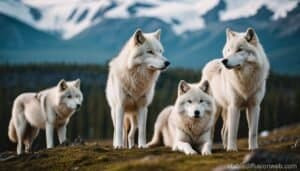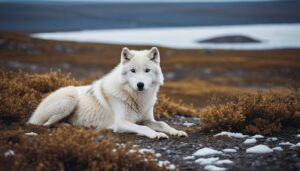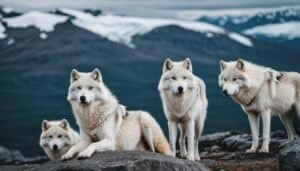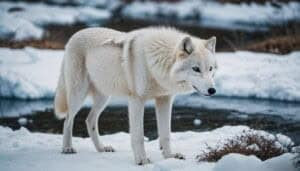Introduction
The habitat range of Arctic wolves is intricately linked to the availability of prey. This article delves into the types of prey hunted by these wolves, the effects of prey scarcity on their movement patterns, and the factors influencing prey availability in the Arctic
It also explores the impact of seasonal changes on prey populations, the relationship between prey density and wolf pack size, and the adaptations of Arctic wolves to varying prey availability
Additionally, we will discuss the hunting strategies of Arctic wolves, the influence of human activity on prey availability, and the ecological consequences of fluctuating prey populations
The Relationship Between Prey Availability and Arctic Wolves’ Habitat
Arctic wolves’ habitat ranges are highly dependent on the availability of prey. These adaptable predators rely on various prey species to survive in the harsh Arctic environment
Understanding the relationship between prey availability and the habitat range of Arctic wolves requires examining the types of prey they hunt, the effects of prey scarcity on their movement patterns, and the factors influencing prey availability in the Arctic
Types of Prey Hunted by Arctic Wolves
Arctic wolves primarily hunt a range of prey species, including Arctic hares, lemmings, and larger animals like caribou and musk oxen. Their diet can vary significantly depending on the season and geographical location
During the summer months, smaller mammals and birds become more accessible, while in the winter, Arctic wolves often rely on larger prey to sustain themselves. The availability of these prey species directly influences the wolves’ hunting grounds and, consequently, their habitat range
Effects of Prey Scarcity on Movement Patterns
Prey scarcity forces Arctic wolves to expand their hunting territories in search of food. When prey is abundant, wolves can maintain smaller, more stable home ranges
However, during periods of prey scarcity, wolves may travel great distances, sometimes over hundreds of miles, to locate adequate food sources. This increased mobility can lead to conflicts with other wolf packs and increased exposure to human activities, impacting their overall survival and distribution
Factors Influencing Prey Availability in the Arctic
Several factors affect prey availability in the Arctic, including climatic conditions, vegetation cover, and predator-prey dynamics. Harsh winters with heavy snowfall can reduce the populations of smaller mammals, making it harder for Arctic wolves to find food
Additionally, changes in vegetation due to climate change can alter the habitat suitability for prey species, further affecting their populations. Predator-prey dynamics, such as competition with other predators like polar bears and red foxes, also play a crucial role in determining prey availability
Seasonal Changes and Their Impact on Prey Population
Seasonal changes significantly impact the prey population in the Arctic, which in turn influences the habitat range of Arctic wolves. The extreme conditions of the Arctic environment result in distinct seasonal variations that affect prey availability and distribution
Understanding these seasonal dynamics is crucial for comprehending how Arctic wolves adapt their hunting strategies and habitat range throughout the year
Winter Prey Availability
During the harsh Arctic winter, prey availability is at its lowest. Snow cover and frigid temperatures make it challenging for smaller mammals like Arctic hares and lemmings to survive. As a result, Arctic wolves often rely on larger prey such as caribou and musk oxen, which are more resilient to the cold
However, finding and hunting these larger animals requires significant energy expenditure, leading wolves to cover larger areas in search of food. The scarcity of prey during winter months forces Arctic wolves to be more mobile, increasing their habitat range
Summer Prey Dynamics
The summer months bring a relative abundance of food sources for Arctic wolves. Melting snow and milder temperatures lead to a surge in the populations of smaller mammals, birds, and fish
Arctic hares and lemmings become more plentiful, providing easier and more frequent meals for the wolves. This abundance allows Arctic wolves to reduce their hunting territories and focus on more localized areas. The increase in prey availability during the summer supports the growth and stability of wolf packs, as the need for extensive travel diminishes
Prey Density and Arctic Wolf Pack Size
The density of prey populations has a profound impact on the behavior and structure of Arctic wolf packs. Higher prey density generally supports larger and more stable wolf packs, while low prey density can lead to smaller packs and increased competition for food resources
This section explores how prey density influences pack behavior and the adaptations Arctic wolves have developed to cope with varying prey availability
Influence of Prey Density on Pack Behavior
In regions with high prey density, Arctic wolves tend to form larger packs. These packs can efficiently hunt and take down larger prey such as caribou and musk oxen, which require coordinated group hunting strategies. Larger packs also have the advantage of protecting their kills from scavengers and other predators
Conversely, in areas where prey is scarce, wolf packs are often smaller. Smaller packs or solitary wolves are more agile and require fewer resources to sustain themselves, which is beneficial in areas with low prey density. The size and cohesion of a wolf pack are directly related to the abundance and distribution of their prey
Adaptations to Prey Availability
Arctic wolves have evolved several adaptations to survive in an environment where prey availability can be unpredictable. They exhibit remarkable stamina and endurance, allowing them to travel long distances in search of food
Their keen sense of smell helps them locate prey hidden beneath the snow. Additionally, Arctic wolves can endure long periods without food, relying on their fat reserves during times of scarcity. These adaptations enable Arctic wolves to maintain their presence across vast and varied landscapes, despite fluctuations in prey density
Hunting Strategies of Arctic Wolves
Arctic wolves employ a variety of hunting strategies to cope with the changing availability of prey in their harsh environment. These strategies are essential for their survival, as they must adapt to different conditions and prey types throughout the year
This section examines the changes in hunting techniques and the impact of prey migration on Arctic wolves’ habitat range and behavior
Changes in Hunting Techniques
Arctic wolves adjust their hunting techniques based on the type and availability of prey. During the winter, when larger prey such as caribou and musk oxen are more accessible, wolves often hunt in coordinated packs
This cooperative hunting increases their success rate in capturing these formidable animals. The wolves use strategic planning, surrounding their prey and working together to isolate and bring down a single animal
In contrast, during the summer, when smaller prey like Arctic hares and lemmings are more abundant, Arctic wolves may hunt alone or in smaller groups. Hunting smaller prey requires stealth and speed rather than coordinated pack efforts
This shift in hunting technique allows the wolves to maximize their energy efficiency and adapt to the seasonal changes in prey availability
Impact of Prey Migration
Prey migration significantly influences the habitat range of Arctic wolves. Many of the larger prey species, such as caribou, migrate seasonally to find better grazing areas. Arctic wolves often follow these migrations, adjusting their own movements to stay close to their primary food sources
This seasonal migration can lead wolves to traverse vast distances across the Arctic tundra, expanding their habitat range
The reliance on migratory prey requires Arctic wolves to be highly adaptable and capable of surviving in diverse environments. They must navigate changing landscapes, from the icy expanses of winter to the more temperate regions during the summer months
This dynamic movement pattern ensures that Arctic wolves remain in areas where prey is most abundant, highlighting the critical link between prey migration and wolf habitat range
Human Activity and Prey Availability
Human activities have increasingly impacted the availability of prey for Arctic wolves, leading to changes in their habitat range and survival strategies. As human presence in the Arctic grows, whether through climate change or industrial activities, the effects on the local ecosystem and prey populations become more pronounced
This section explores the effects of climate change and industrial activities on prey availability for Arctic wolves
Effects of Climate Change
Climate change is one of the most significant factors affecting prey availability in the Arctic. Rising temperatures and changing weather patterns alter the habitats and behavior of many prey species. For instance, milder winters with less snow cover can reduce the populations of small mammals like lemmings and Arctic hares, which rely on snow for insulation and protection
Additionally, the thawing of permafrost and changes in vegetation can impact the grazing patterns of larger prey like caribou and musk oxen
These environmental changes force Arctic wolves to adapt their hunting strategies and expand their habitat range to find sufficient food. Wolves may need to travel further and into unfamiliar territories, increasing the risk of encounters with humans and other dangers
The unpredictability of climate change adds another layer of complexity to the already challenging survival of Arctic wolves
Impact of Industrial Activities
Industrial activities such as mining, oil exploration, and transportation infrastructure development also have profound effects on prey availability for Arctic wolves. These activities can lead to habitat destruction, pollution, and increased human presence, all of which disrupt the natural balance of the Arctic ecosystem
For example, mining operations can destroy crucial habitats for prey species, reducing their numbers and making it harder for wolves to find food
Additionally, the noise and activity associated with industrial operations can cause prey animals to alter their behavior and distribution. Caribou, for instance, might avoid areas with heavy human activity, forcing wolves to follow them into less disturbed regions
This displacement can fragment wolf populations and limit their access to essential prey resources
Furthermore, industrial activities often bring increased access to previously remote areas, leading to more frequent human-wolf interactions. These encounters can result in conflicts, such as wolves preying on livestock, which often lead to wolves being hunted or relocated
The overall impact of industrial activities on Arctic wolves is complex, involving both direct and indirect effects on their prey and habitat
Ecological Consequences of Fluctuating Prey Populations
The fluctuating populations of prey species in the Arctic have significant ecological consequences for Arctic wolves. These fluctuations affect not only the wolves but also the broader ecosystem, influencing predator-prey dynamics and the long-term stability of wildlife populations
This section examines the predation pressure on prey species and the long-term effects on Arctic wolf populations
Predation Pressure on Prey Species
Arctic wolves exert considerable predation pressure on their prey species, particularly when prey populations are low. During periods of scarcity, wolves must hunt more intensively to meet their nutritional needs, which can lead to overhunting of certain prey populations
For instance, when the populations of smaller mammals like lemmings and Arctic hares decline, wolves may turn to larger prey such as caribou, increasing the predation pressure on these species
This intensified hunting can have cascading effects throughout the ecosystem. Overhunting can lead to significant declines in prey populations, disrupting the natural balance and potentially causing long-term damage to the ecosystem
Additionally, prey species under high predation pressure may alter their behavior, such as changing their grazing patterns or migrating to safer areas, further impacting the availability of food for Arctic wolves
Long-Term Effects on Arctic Wolf Populations
Fluctuating prey populations have long-term implications for Arctic wolf populations. Consistent prey shortages can lead to reduced reproductive success and higher mortality rates among wolves. Malnutrition and starvation are significant risks, especially for wolf pups and older individuals
In some cases, prolonged prey scarcity can result in smaller, less stable wolf packs, making it harder for wolves to hunt effectively and protect their territory
Over time, the stress of fluctuating prey availability can lead to genetic and behavioral adaptations in Arctic wolf populations. Wolves may develop new hunting techniques, alter their social structures, or expand their habitat range to cope with the changing environment
These adaptations are crucial for their survival, but they also reflect the broader impacts of ecological changes on predator species
Furthermore, the decline or displacement of Arctic wolf populations can have ripple effects throughout the ecosystem. As apex predators, wolves play a crucial role in maintaining the health and balance of the Arctic environment
Their presence helps regulate prey populations and promotes biodiversity. Therefore, the long-term stability of Arctic wolf populations is essential for the overall health of the Arctic ecosystem
Conclusion
The habitat range of Arctic wolves is intricately linked to the availability of prey in the harsh Arctic environment. Various factors, including the types of prey hunted, seasonal changes, prey density, and human activities, play crucial roles in shaping the wolves’ habitat and survival strategies
Arctic wolves adapt their hunting techniques and pack behaviors based on prey availability, adjusting to the dynamic and often unpredictable conditions of the Arctic
Seasonal changes bring about significant fluctuations in prey populations, with winter scarcity forcing wolves to travel greater distances and summer abundance allowing for more localized hunting. The density of prey populations affects pack size and behavior, with higher densities supporting larger packs and lower densities leading to smaller, more mobile groups
Arctic wolves have developed numerous adaptations to cope with these variations, including stamina for long-distance travel and flexibility in hunting strategies
Human activities, particularly climate change and industrial development, further influence prey availability, disrupting natural habitats and altering prey behavior. These changes necessitate greater adaptability from Arctic wolves, who must navigate an increasingly fragmented and unpredictable landscape
The ecological consequences of fluctuating prey populations highlight the delicate balance within the Arctic ecosystem. Predation pressure from Arctic wolves can lead to significant impacts on prey species, affecting their behavior and population dynamics. Long-term prey shortages pose risks to wolf populations, leading to changes in reproductive success and pack stability
Understanding the complex interplay between prey availability and the habitat range of Arctic wolves underscores the importance of conservation efforts to protect both prey species and their predators. Preserving the natural balance of the Arctic ecosystem is essential for the survival of Arctic wolves and the overall health of this unique environment










